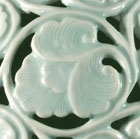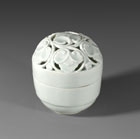J.J. Lally & Co., Oriental Art / New York City, New York
MenuPast Exhibition
SONG DYNASTY CERAMICS:
The Ronald W. Longsdorf Collection
March 15 - April 13, 2013
18.
A QINGBAI GLAZED CARVED OPENWORK PORCELAIN CENSER
Northern Song Dynasty (A.D. 960-1127)
in the form of a tall box with domed cover very finely carved in openwork with a repeating pattern of exotic trefoil leaf motifs in stepped relief borne on scrolling vine in a lively curling symmetrical arrangement, the surface embellished with combed and incised details throughout, the deep straight sides of the cover fitting flush over the inner rim of the lower half of the box, the underside rounded in to a shallow ring foot enclosing a countersunk flat base, covered inside and out with a lustrous translucent glaze of pale bluish tone, the rims and base unglazed, showing the white porcelain, with brown firing marks from the kiln support around the inner rim of the base.
Height 4 7⁄8 inches (12.4 cm)
A very similar Qingbai openwork censer excavated in 1976 from a ‘digong’ underground dedication chamber below the foundation of the Baozhi Pagoda at Linggu Temple, Nanjing city, now in the Nanjing Museum, is illustrated by Zhang (ed.) in Zhongguo chutu ciqi quanji (7) Jiangsu, Shanghai (Complete Collection of Ceramic Art Unearthed in China, Vol. 7, Jiangsu, Shanghai), Beijing, 2008, p. 112, no. 112, described as “made by the Jingdezhen kilns in Jiangxi.” A Yueyao celadon-glazed censer carved with a very similar openwork design, in the Changzhou Museum, Jiangsu province, is illustrated in Zhongguo taoci quanji (8) Song, xia (The Complete Works of Chinese Ceramics, Vol. 8, Song II), Shanghai, 1999, p. 84, no. 43.
Another Qingbai glazed openwork censer of closely related form and size with a less elaborate lotus scroll top is illustrated by Tseng and Dart in The Charles B. Hoyt Collection in the Museum of Fine Arts: Boston, Vol. II, Boston, 1972, no. 65.
Compare also the miniature Qingbai glazed openwork censer illustrated by Krahl in Chinese Ceramics from the Meiyintang Collection, Volume One, London, 1994, pp. 328-329, no. 611, where the author mentions a miniature silver openwork censer on a tall hexagonal stand which was excavated from the underground dedication chamber beneath the Tianfeng pagoda at Ningpo, Zhejiang province, erected in A.D. 1144-5, illustrated in Wenwu, 1991, No. 6, pl. 3, fig. 2. Another miniature Qingbai glazed openwork censer of related form, excavated from a Song dynasty tomb dated by epitaph to the sixth year of Zhenghe (A.D. 1116) at Taixing, Jiangxi province is illustrated in Zhongguo wenwu jinghua daquan: Taoci juan (Compendium of Chinese Archaeological Treasures: Ceramics), Hong Kong 1993, p. 286, no. 390.
北宋 青白透雕香薰 高 12.4 厘米

